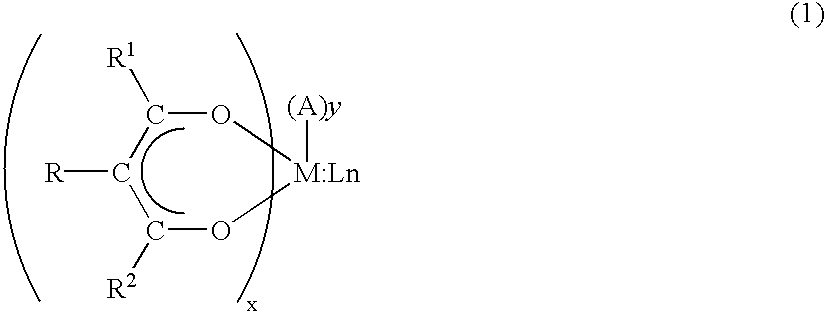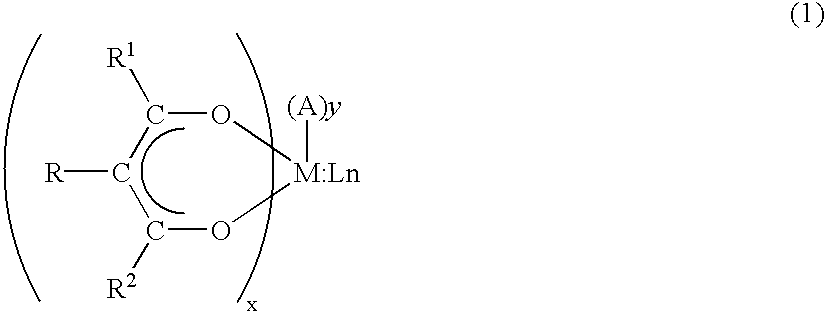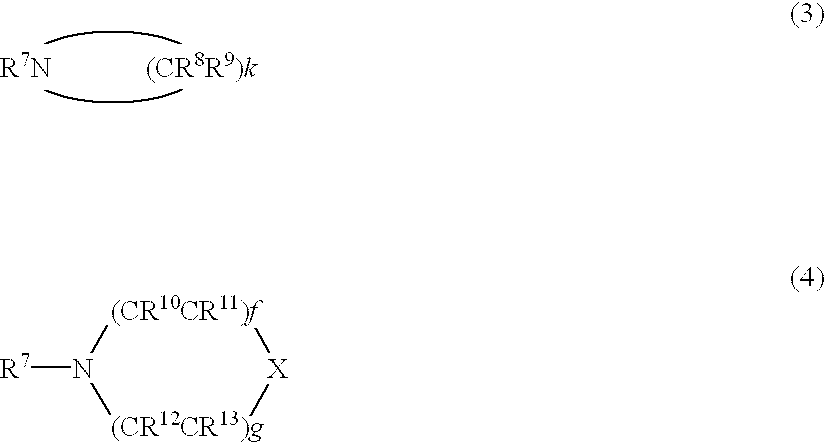Precursor compounds for metal oxide film deposition and methods of film deposition using the same
a metal oxide film and precursor compound technology, applied in the field of precursor compounds for metal oxide film deposition, can solve the problems of a serious increase in the confidence of the element, a very complicated structure, and limited application of a three-dimensional steric structure to the capacitor
- Summary
- Abstract
- Description
- Claims
- Application Information
AI Technical Summary
Problems solved by technology
Method used
Image
Examples
example 2
Synthesis of titanium(1-methoxy-2-propoxy).sub.2(tetramethylheptanedionate-).sub.2
[0063] According to the procedure of Example 1, 387 g (2.1 mol) of tetramethylheptanedione was added to 284 g (1 mol) of titanium(isopropoxide).sub.4 and then the mixture was stirred for 3 hours at room temperature. Then, 361 g (4 mol) of 1-methoxy-2-propanol was added to the mixture and stirred for 6 hours at 50.degree. C. to complete the reaction.
[0064] After the reaction was completed, in order to remove any volatile side product the mixture was dried under vacuum at 70.degree. C. to obtain 504 g of the solid titanium(1-methoxy-2-propoxy).sub.2(tetramethyl-heptanedionate).sub.2.
[0065] The resulting solid titanium(1-methoxy-2-propoxy).sub.2(tetramethyl-heptanedionate).sub.2 was sublimed at 150.degree. C. under vacuum (10.sup.-2 torr) to purify the product.
[0066] The chemical reaction for preparing titanium(1-methoxy-2-propoxy).s-ub.2(tetramethyl-heptanedionate).sub.2 according to the present inventio...
example 3
Synthesis of titanium(1-methoxy-2-butoxy).sub.2(tetramethyl-heptanedionate-).sub.2
[0067] According to the procedure of Example 1, 387 g (2.1 mol) of tetramethylheptanedione was added dropwise to 284 g (1 mol) of titanium(isopropoxide).sub.4 and then the mixture was stirred. Then, 417 g (4 mol) of 1-methoxy-2-butanol was added to the mixture and the reaction was completed. The reaction mixture was dried under vacuum to obtain 521 g of the solid titanium(1-methoxy-2-butoxy).sub.2(tetramethylh-eptane-dionate).sub.2.
[0068] The dried titanium(1-methoxy-2-butoxy).sub.2(tetramethylheptanedion-ate).sub.2 was sublimed at 160.degree. C. under vacuum to purify the product.
[0069] The chemical reaction for preparing titanium(1-methoxy-2-butoxy).su-b.2(tetramethyl-heptanedionate).sub.2 is represented by the following reaction scheme 4 and it was confirmed from the analytical data as determined by NMR spectroscopy and the observed physical properties, as shown in the following Table 1, that the re...
example 4
Synthesis of titanium(3-methoxy-1-butoxy).sub.2(tetramethylheptanedionate)-.sub.2
[0070] According to the procedure of Example 1, 387 g (2.1 mol) of tetramethyl-heptanedione was added dropwise to 284 g (1 mol) of titanium(isopropoxide).sub.4 and then the mixture was stirred. Then, 417 g (4 mol) of 3-methoxy-1-butanol was added to the mixture and the reaction was completed.
[0071] After the reaction was completed, the mixture was dried under vacuum at about 70.degree. C. and then distilled twice at 145.degree. C. under vacuum to obtain 559 g of the pale yellow liquid titanium(3-methoxy-1-butoxy).sub.2(tetramethylheptanedionate).sub.2 having a high purity.
[0072] The chemical reaction for preparing titanium(3-methoxy-1-butoxy).su-b.2(tetramethyl-heptanedionate).sub.2 is represented by the following reaction scheme 5 and it was confirmed from the analytical data as determined by NMR spectroscopy and the observed physical properties, as shown in the following Table 1, that the resulting pr...
PUM
| Property | Measurement | Unit |
|---|---|---|
| temperature | aaaaa | aaaaa |
| thickness | aaaaa | aaaaa |
| temperature | aaaaa | aaaaa |
Abstract
Description
Claims
Application Information
 Login to View More
Login to View More - R&D
- Intellectual Property
- Life Sciences
- Materials
- Tech Scout
- Unparalleled Data Quality
- Higher Quality Content
- 60% Fewer Hallucinations
Browse by: Latest US Patents, China's latest patents, Technical Efficacy Thesaurus, Application Domain, Technology Topic, Popular Technical Reports.
© 2025 PatSnap. All rights reserved.Legal|Privacy policy|Modern Slavery Act Transparency Statement|Sitemap|About US| Contact US: help@patsnap.com



